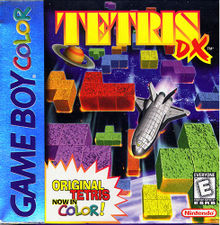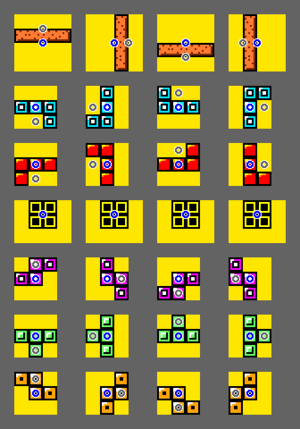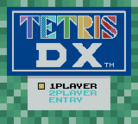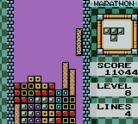Tetris DX: Difference between revisions
No edit summary |
No edit summary |
||
| Line 23: | Line 23: | ||
* [[40 lines]] | * [[40 lines]] | ||
* Vs. CPU opponent | * Vs. CPU opponent | ||
=== Marathon === | |||
Speed curve: | |||
{| class="wikitable" | |||
|- | |||
!Level | |||
!Frames per row | |||
|- | |||
|0 || 52 | |||
|- | |||
|1 || 48 | |||
|- | |||
|2 || 44 | |||
|- | |||
|3 || 40 | |||
|- | |||
|4 || 36 | |||
|- | |||
|5 || 32 | |||
|- | |||
|6 || 27 | |||
|- | |||
|7 || 21 | |||
|- | |||
|8 || 16 | |||
|- | |||
|9 || 10 | |||
|- | |||
|10 || 9 | |||
|- | |||
|11 || 8 | |||
|- | |||
|12 || 7 | |||
|- | |||
|13 || 6 | |||
|- | |||
|14 || 5 | |||
|- | |||
|15 || 5 | |||
|- | |||
|16 || 4 | |||
|- | |||
|17 || 4 | |||
|- | |||
|18 || 3 | |||
|- | |||
|19 || 3 | |||
|- | |||
|20 || 2 | |||
|} | |||
== Power == | == Power == | ||
| Line 101: | Line 153: | ||
<br clear="all"> | <br clear="all"> | ||
== Other gameplay notes == | |||
Scoring uses the Nintendo system, however the score multiplier is capped at 21 (25200 per Tetris). | |||
Timings: | |||
* DAS: 9 frames startup, 3 frames repeat. | |||
* Lock delay: 32 frames or (frames per row + 4), whichever is larger. | |||
* ARE: equal to lock delay, can be cancelled. | |||
* Line clear delay: 50 frames. | |||
== External links == | == External links == | ||
*[http://www.din.or.jp/~koryan/tetris/roll-o2.htm#03 Koryan's description of Sega Tetris, TGM, and Tetris DX rotation systems (Japanese language)] | *[http://www.din.or.jp/~koryan/tetris/roll-o2.htm#03 Koryan's description of Sega Tetris, TGM, and Tetris DX rotation systems (Japanese language)] | ||
Revision as of 00:41, 21 February 2022
- Not to be confused with Tetris Deluxe, a game released for western mobile phones.
| Tetris DX | |
|---|---|
 | |
| Developer(s) | Nintendo |
| Publisher(s) | Nintendo |
| Platform(s) | Game Boy Color |
| Release |
|
| Gameplay info | |
| Next pieces | 1 |
| Playfield size | 10 × 18 |
| Hold piece | No |
| Hard drop | No |
| Rotation system | Bounding box, wall kick, SRS predecessor |
Tetris DX is a Game Boy Color game that enhances Nintendo's original Game Boy Tetris, with three new gameplay modes, a profile/save feature, and color graphics on Game Boy Color games and above. The game's rotation system has a glitch which lets players move any tetromino, except the O-piece, upward by holding the direction against a wall and rotating in the opposite direction.
Modes
Marathon
Speed curve:
| Level | Frames per row |
|---|---|
| 0 | 52 |
| 1 | 48 |
| 2 | 44 |
| 3 | 40 |
| 4 | 36 |
| 5 | 32 |
| 6 | 27 |
| 7 | 21 |
| 8 | 16 |
| 9 | 10 |
| 10 | 9 |
| 11 | 8 |
| 12 | 7 |
| 13 | 6 |
| 14 | 5 |
| 15 | 5 |
| 16 | 4 |
| 17 | 4 |
| 18 | 3 |
| 19 | 3 |
| 20 | 2 |
Power
Gameplay data is recorded and stored as "POWER". Each profile has its own POWER data. Using a link cable, this data can be transferred to another cart.
In VS. COM, this can be used to play vs a CPU against a local profile, or a transfered profile's game data.
Your power increases as you play better games using your profile.
Rotation system

The rotation system is an early version of what would become SRS. Like in SRS, tetrominoes of width 3 rotate as if in a bounding square; unlike in SRS, L, J, and T start flat side up. TDX first tries rotation about the center of the box (the blue circle). If this fails, it tries rotation about an alternate center displaced by one cell (the gray circle). For I, S, and Z, this center starts out one cell above the ordinary center; for L, J, or T, it starts out one cell below.
Wall climbing
This rotation system is exploitable, especially on low levels:
Charge DAS |
Rotate left |
Shift left (DAS) |
Rotate right about |
This particular exploit was fixed in SRS.
Infinity
Ordinarily, Tetris DX lock delay follows step reset behavior: only downward motion under gravity resets the lock delay timer. But rotation about the alternate center does reset the timer used for gravity. This can be exploited by placing a piece in a corner and rotating it back and forth about the alternate center:
|
|
Other gameplay notes
Scoring uses the Nintendo system, however the score multiplier is capped at 21 (25200 per Tetris).
Timings:
- DAS: 9 frames startup, 3 frames repeat.
- Lock delay: 32 frames or (frames per row + 4), whichever is larger.
- ARE: equal to lock delay, can be cancelled.
- Line clear delay: 50 frames.
External links
| ||||||||||||||

